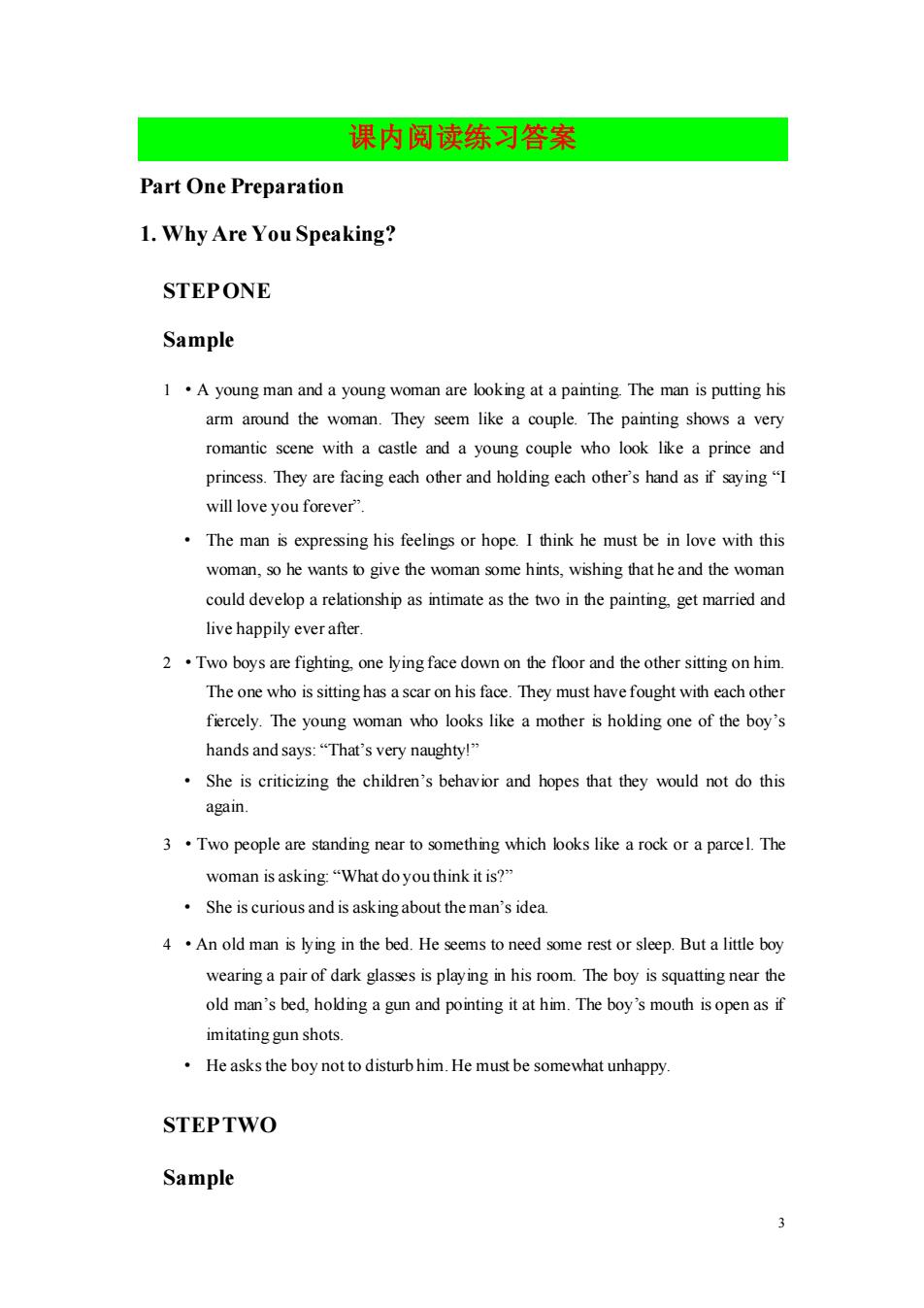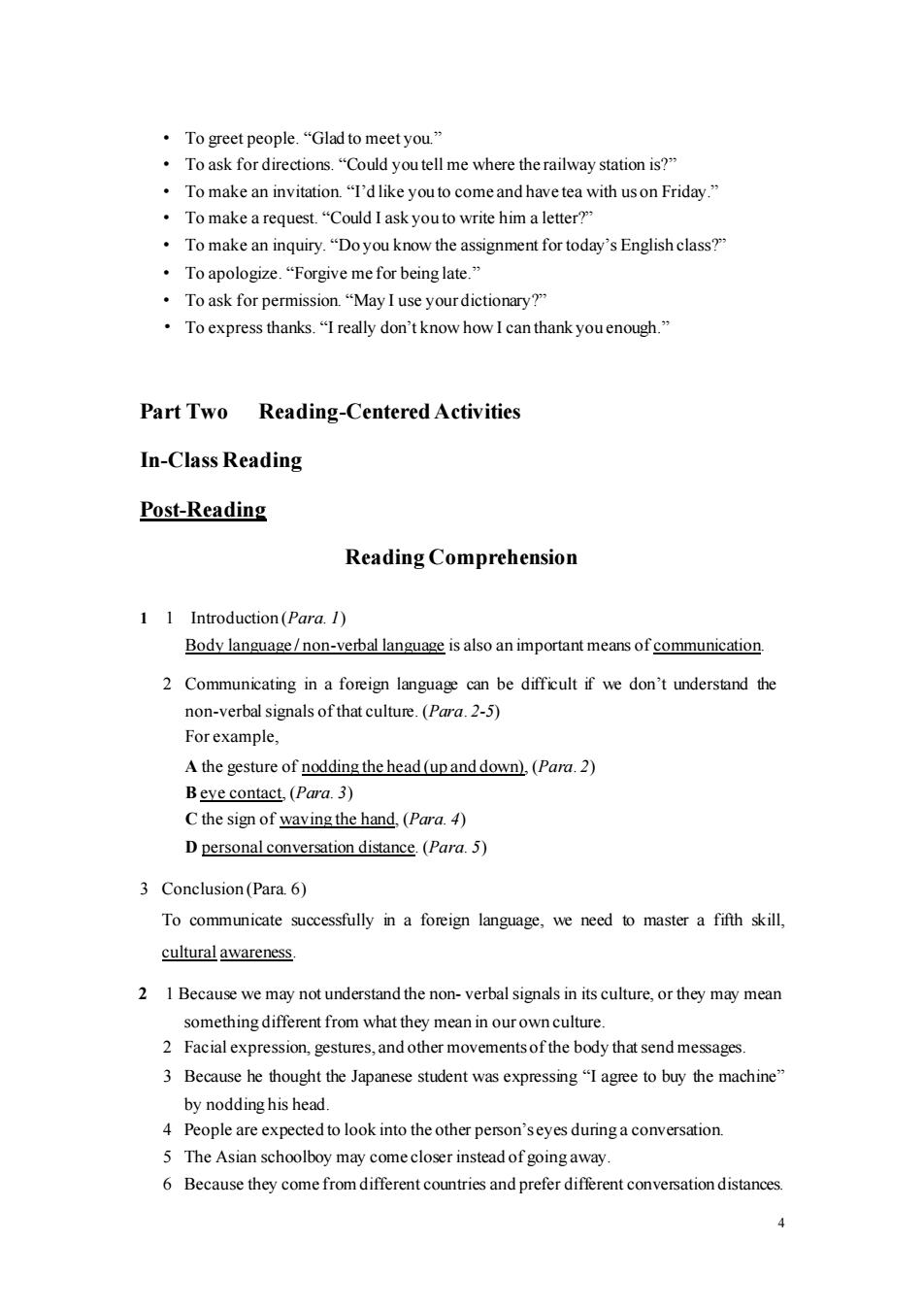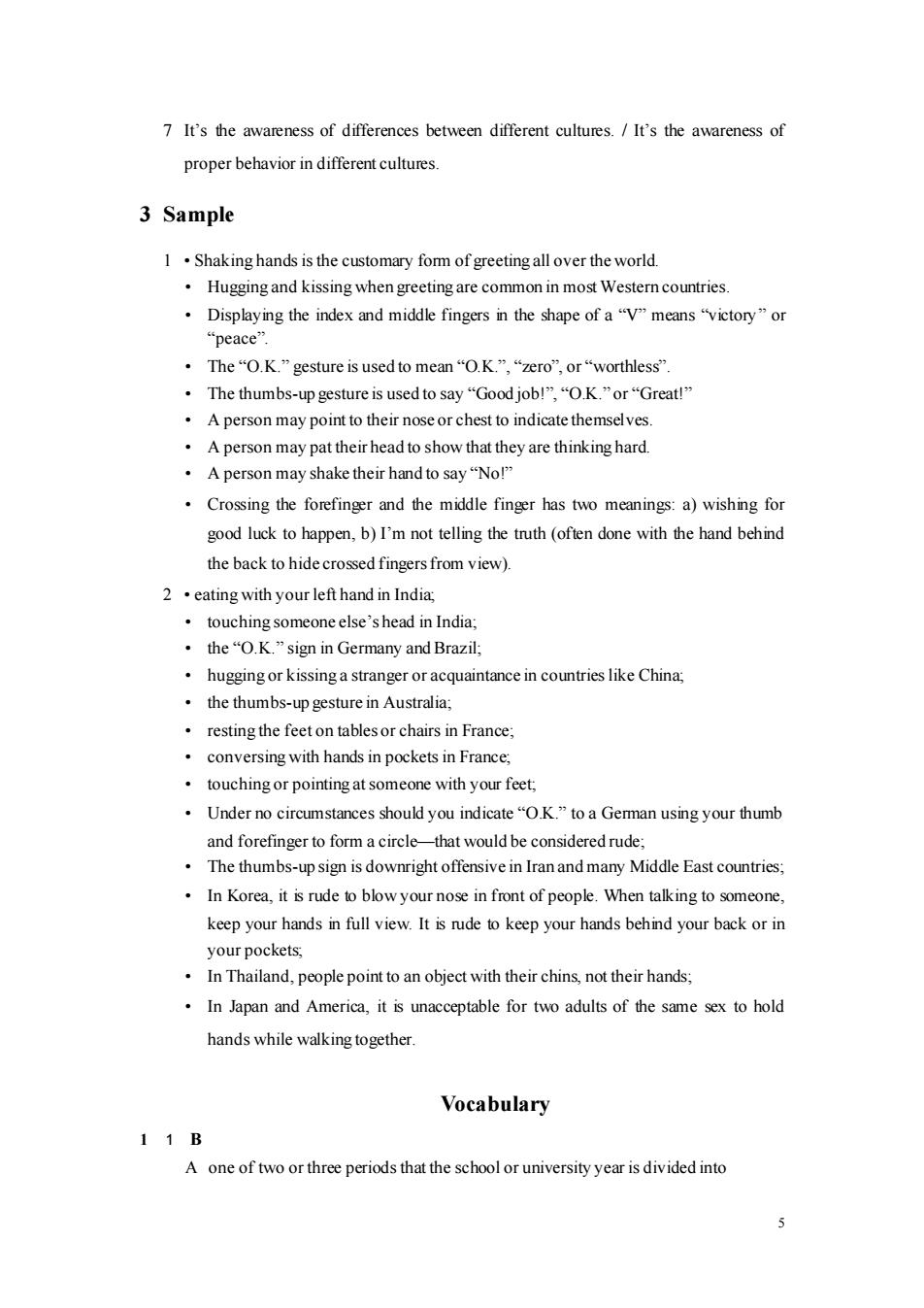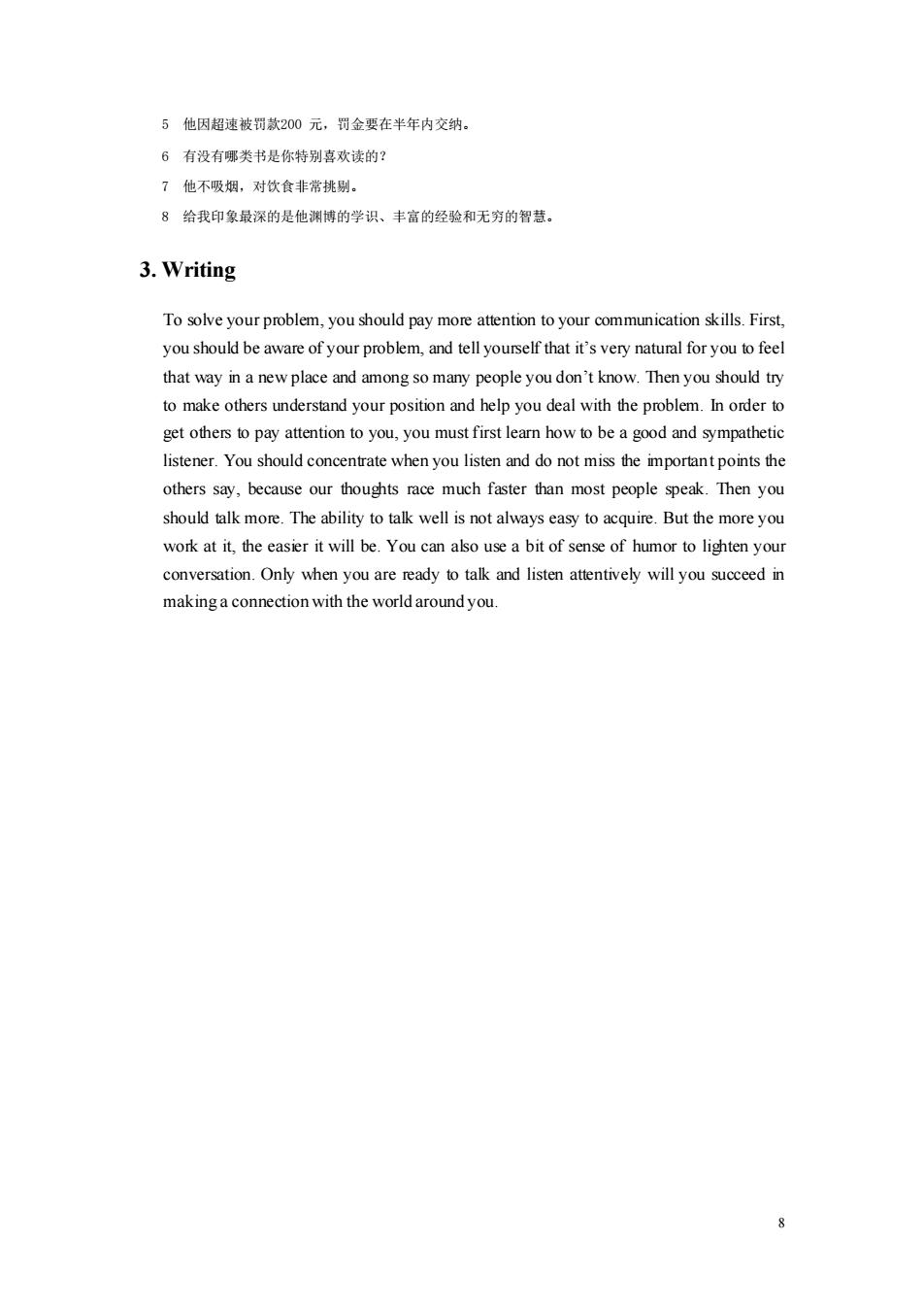
Unit 1 More Than Words In-Class Reading Communication Without Words 不用话语的交流 1当你学一门外语时,你要学的不仅仅是词汇和语法。要想成功地进行交谈,你还必须 学习该种文化的非言语性语言,或者说“肢体语言”。“肢体语言”是用来描述那些可以传 递信息的脸部表情、手势以及其他身体动作的术语。这种交流方法非常重要,实际上我们用 动作表达的信息比用言语表达的信息还要多。 2有时候我们发现说一门外语很困难,因为我们可能不了解另一种文化的非言语信号, 或者说那些信号在我们自己文化中的含义可能迥然不同。例如,在世界上不同的地方,上 下点头就传递不同的信息。在北美,该动作表示“我同意”。在中东,向下点头表示“我 同意”,而向上抬头表示“我不同意”。日本人谈话的时候这个动作通常只是表示“我正 在听”。一位在美国的日本学生好不容易才了解了其中的差异。在和一位推销员说话的时 候,这位学生礼貌性地点头,表示他在注意听着。结果,第二天那位推销员就将一台崭新 的洗衣机送到了他的公寓。 3目光接触所表达的含义也很丰富,但是,在不同的文化中,它表达的意思也不同。在 一些讲西班牙语的国家,孩子们在与年长者谈话时不直视对方的眼睛,以表示尊重。而在 其他国家,别人则期待你看着他的眼睛。例如,如果你在美国不这么做的话,人们会以为 你害怕、尴尬或者生气了。 4世界上很多地方都用两种基本的手势来招呼别人朝自己走过来。在亚洲,人们把手指 朝下微曲,做摆手的动作,而有些北美人则用该动作向孩子们道别。北美人用类似的手势 招呼别人走过来,但是他们的手指是向上弯曲。去国外参观的人必须了解这种差别,否则 就会传递错误的信息。 5我们在谈话时与对方保持的距离同样也是交流的一个重要方面,虽然我们很少想到这 一点。通常,北美人比拉丁美洲人和中东人更喜欢彼此间距离大一点。在国际会议上,谈 话的两个外交官可能会慢慢地从房间的这一头移到那一头,其中一个想竭力拉大彼此间的 距离,而另一个则想竭力缩短这一距离。通常,喜欢距离大点儿的那个人往往退到背靠墙, 无路可退为止,他(拉大距离)的努力也以失败告终。 6尽管我们花了许多年时间来学习一门外语,如果我们不了解该文化的非言语性语言和 得体的举止的话,就会产生误解。如果我们不知道应该握手还是鞠躬,什么时候坐着,什 么时候站着,在不熟悉的场合应该有什么样的举止,那么我们就没有真正具备用外语交流 的能力。或许在读、写、说、听四项传统的交流技能之外还应该加上第五项技能:文化意 1
1 Unit 1 More Than Words In-Class Reading Communication Without Words 不用话语的交流 1 当你学一门外语时,你要学的不仅仅是词汇和语法。要想成功地进行交谈,你还必须 学习该种文化的非言语性语言,或者说“肢体语言”。“肢体语言”是用来描述那些可以传 递信息的脸部表情、手势以及其他身体动作的术语。这种交流方法非常重要,实际上我们用 动作表达的信息比用言语表达的信息还要多。 2 有时候我们发现说一门外语很困难,因为我们可能不了解另一种文化的非言语信号, 或者说那些信号在我们自己文化中的含义可能迥然不同。例如,在世界上不同的地方,上 下点头就传递不同的信息。在北美,该动作表示“我同意”。在中东,向下点头表示“我 同意”,而向上抬头表示“我不同意”。日本人谈话的时候这个动作通常只是表示“我正 在听”。一位在美国的日本学生好不容易才了解了其中的差异。在和一位推销员说话的时 候,这位学生礼貌性地点头,表示他在注意听着。结果,第二天那位推销员就将一台崭新 的洗衣机送到了他的公寓。 3 目光接触所表达的含义也很丰富,但是,在不同的文化中,它表达的意思也不同。在 一些讲西班牙语的国家,孩子们在与年长者谈话时不直视对方的眼睛,以表示尊重。而在 其他国家,别人则期待你看着他的眼睛。例如,如果你在美国不这么做的话,人们会以为 你害怕、尴尬或者生气了。 4 世界上很多地方都用两种基本的手势来招呼别人朝自己走过来。在亚洲,人们把手指 朝下微曲,做摆手的动作,而有些北美人则用该动作向孩子们道别。北美人用类似的手势 招呼别人走过来,但是他们的手指是向上弯曲。去国外参观的人必须了解这种差别,否则 就会传递错误的信息。 5 我们在谈话时与对方保持的距离同样也是交流的一个重要方面,虽然我们很少想到这 一点。通常,北美人比拉丁美洲人和中东人更喜欢彼此间距离大一点。在国际会议上,谈 话的两个外交官可能会慢慢地从房间的这一头移到那一头,其中一个想竭力拉大彼此间的 距离,而另一个则想竭力缩短这一距离。通常, 喜欢距离大点儿的那个人往往退到背靠墙, 无路可退为止,他( 拉大距离) 的努力也以失败告终。 6 尽管我们花了许多年时间来学习一门外语,如果我们不了解该文化的非言语性语言和 得体的举止的话,就会产生误解。如果我们不知道应该握手还是鞠躬,什么时候坐着,什 么时候站着,在不熟悉的场合 应该有什么样的举止,那么我们就没有真正具备用外语交流 的能力。或许在读、写、说、听四项传统的交 流技能之外还应该加上第五项技能:文化意

识。 After-Class Reading How to Talk to Anyone,Anytime,Anywhere 如何同任何人在任何时间、任何场合交谈 1 善于交谈是生活中的一大乐趣,还能给生活带来一些巨大的回报。有时候这并不是件 容易的事。但是,你练习得越多,就越善于交谈。如果你希望能够和任何人在任何时间和任 何场合交谈,你需要牢记六个要素。 2首先,你说的话无需精辟到值得让人引用。很多时候,别人并不期待你说出隽语。他 们也不会等着把你所说的话录下来。因此,尽管开口讲话吧。希望你的谈吐有趣,足以吸引 听众。 3第二,正确的态度一一交谈的愿望一一是成为一个能说会道者的根本。与人交谈时尽 量热情些。别人也会对你的热情做出积极的反应,而且你会发现自己的确也变得满腔热情。 另一方面,如果你与他人交谈时缺乏热情,他们也很容易发现,从而做出消极的反应。 4第三点要记住的是要轮流说话。仔细倾听会使你变得更善于交谈。交谈中好的提问也 是出色交谈者的标志。倾听是每个人学习的一种方式。学到的越多,你为自己成为一名优秀 交谈者所做的准备就越充分。 5第四个要点是应该努力开阔眼界。最优秀的交谈者能够谈论日常生活之外的事情和经 历。你可以通过旅游拓宽你的世界,但也可以足不出户就做到这一点。当然,你可以通过阅 读学习。但是,要记住的一个要点是,那些与你背景不同的人可以开阔你谈话的内容和拓展 你的思维。 6 第五点要记住的是,严肃的谈话时间不应过长。幽默感很有用,有时讲个和自己有关 的小笑话会使谈话轻松起来。 7最后,与人交谈要真诚。你应该对你的交谈对象坦率、诚实,正如你也希望他们这样 对待你一样。你要乐意告诉他们你的背景以及个人好恶。这是谈话中互相理解、平等交换的 一个重要方面,一个了解别人和让别人了解自己的重要方面。坦诚示人,这样准没错。 8无论你和一个人交谈还是和许多人交谈,规则都是一样的,都是为了建立联系。只要 表现出你的同情心、热情和倾听的愿望,你就一定会成为一名谈话大师。 2
2 识。 After-Class Reading How to Talk to Anyone, Anytime, Anywhere 如何同任何人在任何时间、任何场合交谈 1 善于交谈是生活中的一大乐趣,还能给生活带来一些巨大的回报。有时候这并不是件 容易的事。但是,你练习得越多,就越善于交谈。如果你希望能够和任何人在任何时间和任 何场合交谈,你需要牢记六个要素。 2 首先,你说的话无需精辟到值得让人引用。很多时候,别人并不期待你说出隽语。他 们也不会等着把你所说的话录下来。因此,尽管开口讲话吧。希望你的谈吐有趣,足以吸引 听众。 3 第二,正确的态度——交谈的愿望——是成为一个能说会道者的根本。与人交谈时尽 量热情些。别人也会对你的热情做出积极的反应,而且你会发现自己的确也变得满腔热情。 另一方面,如果你与他人交谈时缺乏热情,他们也很容易发现,从而做出消极的反应。 4 第三点要记住的是要轮流说话。仔细倾听会使你变得更善于交谈。交谈中好的提问也 是出色交谈者的标志。倾听是每个人学习的一种方式。学到的越多,你为自己成为一名优秀 交谈者所做的准备就越充分。 5 第四个要点是应该努力开阔眼界。最优秀的交谈者能够谈论日常生活之外的事情和经 历。你可以通过旅游拓宽你的世界,但也可以足不出户就做到这一点。当然,你可以通过阅 读学习。但是,要记住的一个要点是,那些与你背景不同的人可以开阔你谈话的内容和拓展 你的思维。 6 第五点要记住的是,严肃的谈话时间不应过长。幽默感很有用,有时讲个和自己有关 的小笑话会使谈话轻松起来。 7 最后,与人交谈要真诚。你应该对你的交谈对象坦率、诚实,正如你也希望他们这样 对待你一样。你要乐意告诉他们你的背景以及个人好恶。这是谈话中互相理解、平等交换的 一个重要方面,一个了解别人和让别人了解自己的重要方面。坦诚示人,这样准没错。 8 无论你和一个人交谈还是和许多人交谈,规则都是一样的,都是为了建立联系。只要 表现出你的同情心、热情和倾听的愿望,你就一定会成为一名谈话大师

课内阅读练习答案 Part One Preparation 1.Why Are You Speaking? STEPONE Sample 1.A young man and a young woman are looking at a painting.The man is putting his arm around the woman.They seem like a couple.The painting shows a very romantic scene with a castle and a young couple who look like a prince and princess.They are facing each other and holding each other's hand as if saying"I will love you forever". The man is expressing his feelings or hope.I think he must be in love with this woman,so he wants to give the woman some hints,wishing that he and the woman could develop a relationship as intimate as the two in the painting,get married and live happily ever after. 2 .Two boys are fighting,one lying face down on the floor and the other sitting on him. The one who is sitting has a scar on his face.They must have fought with each other fiercely.The young woman who looks like a mother is holding one of the boy's hands and says:"That's very naughty!" She is criticizing the children's behavior and hopes that they would not do this again. 3 Two people are standing near to something which looks like a rock or a parcel.The woman is asking:"What do you think it is?" She is curious and is asking about the man's idea. 4 An old man is lying in the bed.He seems to need some rest or sleep.But a little boy wearing a pair of dark glasses is playing in his room.The boy is squatting near the old man's bed,holding a gun and pointing it at him.The boy's mouth is open as if imitating gun shots. He asks the boy not to disturb him.He must be somewhat unhappy. STEPTWO Sample 3
3 课内阅读练习答案 Part One Preparation 1. Why Are You Speaking? STEP ONE Sample 1 • A young man and a young woman are looking at a painting. The man is putting his arm around the woman. They seem like a couple. The painting shows a very romantic scene with a castle and a young couple who look like a prince and princess. They are facing each other and holding each other’s hand as if saying “I will love you forever”. • The man is expressing his feelings or hope. I think he must be in love with this woman, so he wants to give the woman some hints, wishing that he and the woman could develop a relationship as intimate as the two in the painting, get married and live happily ever after. 2 • Two boys are fighting, one lying face down on the floor and the other sitting on him. The one who is sitting has a scar on his face. They must have fought with each other fiercely. The young woman who looks like a mother is holding one of the boy’s hands and says: “That’s very naughty!” • She is criticizing the children’s behavior and hopes that they would not do this again. 3 • Two people are standing near to something which looks like a rock or a parcel. The woman is asking: “What do you think it is?” • She is curious and is asking about the man’s idea. 4 • An old man is lying in the bed. He seems to need some rest or sleep. But a little boy wearing a pair of dark glasses is playing in his room. The boy is squatting near the old man’s bed, holding a gun and pointing it at him. The boy’s mouth is open as if imitating gun shots. • He asks the boy not to disturb him. He must be somewhat unhappy. STEP TWO Sample

·To greet people.“Glad to meet you.” To ask for directions."Could youtell me where the railway station is?" To make an invitation."I'd like you to come and have tea with us on Friday." To make a request."Could I ask you to write him a letter?" To make an inquiry."Do you know the assignment for today's English class?" ·To apologize.“Forgive me for being late.” To ask for permission."May I use your dictionary?" ·To express thanks.“I really don't know how I can thank you enough.” Part Two Reading-Centered Activities In-Class Reading Post-Reading Reading Comprehension 11 Introduction(Para.1) Body language/non-verbal language is also an important means of communication. 2 Communicating in a foreign language can be difficult if we don't understand the non-verbal signals of that culture.(Para.2-5) For example, A the gesture of nodding the head (up and down),(Para.2) Beye contact,(Para.3) C the sign of waving the hand,(Para.4) D personal conversation distance.(Para.5) 3 Conclusion(Para.6) To communicate successfully in a foreign language,we need to master a fifth skill, cultural awareness. 2 1 Because we may not understand the non-verbal signals in its culture,or they may mean something different from what they mean in our own culture. 2 Facial expression,gestures,and other movements of the body that send messages 3 Because he thought the Japanese student was expressing"I agree to buy the machine" by nodding his head. 4 People are expected to look into the other person'seyes during a conversation 5 The Asian schoolboy may come closer instead of going away 6 Because they come from different countries and prefer different conversation distances
4 • To greet people. “Glad to meet you.” • To ask for directions. “Could you tell me where the railway station is?” • To make an invitation. “I’d like you to come and have tea with us on Friday.” • To make a request. “Could I ask you to write him a letter?” • To make an inquiry. “Do you know the assignment for today’s English class?” • To apologize. “Forgive me for being late.” • To ask for permission. “May I use your dictionary?” • To express thanks. “I really don’t know how I can thank you enough.” Part Two Reading-Centered Activities In-Class Reading Post-Reading Reading Comprehension 1 1 Introduction (Para. 1) Body language / non-verbal language is also an important means of communication. 2 Communicating in a foreign language can be difficult if we don’t understand the non-verbal signals of that culture. (Para. 2-5) For example, A the gesture of nodding the head (up and down), (Para. 2) B eye contact, (Para. 3) C the sign of waving the hand, (Para. 4) D personal conversation distance. (Para. 5) 3 Conclusion (Para. 6) To communicate successfully in a foreign language, we need to master a fifth skill, cultural awareness. 2 1 Because we may not understand the non- verbal signals in its culture, or they may mean something different from what they mean in our own culture. 2 Facial expression, gestures, and other movements of the body that send messages. 3 Because he thought the Japanese student was expressing “I agree to buy the machine” by nodding his head. 4 People are expected to look into the other person’s eyes during a conversation. 5 The Asian schoolboy may come closer instead of going away. 6 Because they come from different countries and prefer different conversation distances

7 It's the awareness of differences between different cultures.It's the awareness of proper behavior in different cultures. 3 Sample 1.Shaking hands is the customary fomm of greeting all over the world. Hugging and kissing when greeting are common in most Western countries. ·Displaying the index and middle fingers in the shape of a“V"means“victory”or “peace”. ·The“O.K.”gesture is used to mean“O.K”,“zero”,or“worthless”. ·The thumbs-up gesture is used to say“Good job!”,“O.K.”or“Great!' A person may point to their nose or chest to indicate themselves. A person may pat their head to show that they are thinking hard. ·A person may shake their hand to say“Nol Crossing the forefinger and the middle finger has two meanings:a)wishing for good luck to happen,b)I'm not telling the truth(often done with the hand behind the back to hide crossed fingers from view). 2 eating with your left hand in India, touching someone else's head in India; ·the“O.K.”sign in Germany and Brazil; hugging or kissing a stranger or acquaintance in countries like China; the thumbs-up gesture in Australia; resting the feet on tables or chairs in France: conversing with hands in pockets in France; touching or pointing at someone with your feet; Under no circumstances should you indicate"O.K."to a German using your thumb and forefinger to form a circle-that would be considered rude: The thumbs-up sign is downright offensive in Iran and many Middle East countries; In Korea,it is rude to blow your nose in front of people.When talking to someone, keep your hands in full view.It is rude to keep your hands behind your back or in your pockets; In Thailand,people point to an object with their chins,not their hands; In Japan and America,it is unacceptable for two adults of the same sex to hold hands while walking together. Vocabulary 11B A one of two or three periods that the school or university year is divided into 5
5 7 It’s the awareness of differences between different cultures. / It’s the awareness of proper behavior in different cultures. 3 Sample 1 • Shaking hands is the customary form of greeting all over the world. • Hugging and kissing when greeting are common in most Western countries. • Displaying the index and middle fingers in the shape of a “V” means “victory” or “peace”. • The “O.K.” gesture is used to mean “O.K.”, “zero”, or “worthless”. • The thumbs-up gesture is used to say “Good job!”, “O.K.” or “Great!” • A person may point to their nose or chest to indicate themselves. • A person may pat their head to show that they are thinking hard. • A person may shake their hand to say “No!” • Crossing the forefinger and the middle finger has two meanings: a) wishing for good luck to happen, b) I’m not telling the truth (often done with the hand behind the back to hide crossed fingers from view). 2 • eating with your left hand in India; • touching someone else’s head in India; • the “O.K.” sign in Germany and Brazil; • hugging or kissing a stranger or acquaintance in countries like China; • the thumbs-up gesture in Australia; • resting the feet on tables or chairs in France; • conversing with hands in pockets in France; • touching or pointing at someone with your feet; • Under no circumstances should you indicate “O.K.” to a German using your thumb and forefinger to form a circle—that would be considered rude; • The thumbs-up sign is downright offensive in Iran and many Middle East countries; • In Korea, it is rude to blow your nose in front of people. When talking to someone, keep your hands in full view. It is rude to keep your hands behind your back or in your pockets; • In Thailand, people point to an object with their chins, not their hands; • In Japan and America, it is unacceptable for two adults of the same sex to hold hands while walking together. Vocabulary 1 1 B A one of two or three periods that the school or university year is divided into

B a word or expression that has a particular meaning,especially in a technical or scientific subject 2 B A the money or income that one has B a way or method of doing or achieving sth. 3A A a gesture,sound or action which is intended to give a particular message B a series of radio waves,light waves,or changes in electrical current that may carry information 4B Aa short written or spoken note B the most important idea in a book,film,speech,etc. 5A A only B in a way that is easy to understand 6A A the act of communication with a person,organization,country,etc. B the state of touching sth. 7B Aa long raised mass of water moving across the surface of the sea B a sign of greeting made by raising and moving the hand 8A A the amount ofarea,room,etc.that is empty or available to be used B the area beyond the Earth where planets,stars,moons,etc.,exist 2 1 gesture 2 signal 3 misunderstanding 4 behaved 5 curls 6 rarely 7 means 8 bow bowed 9 contact 10 facial 11 awareness 12occur Translation 1 You won't get the job unless you've got the experience. 2 I spent most of my time studying the differences between Chinese and American cultures. 3 The statement is so clear that it can't cause any misunderstanding. 4 He wishes he could give her more help than he does. 5 Remember to invite her to the birthday party,or she would complain. 6 "You have to add $2,500 for equipment purchase buying equipment to the cost,"said the director. 6
6 B a word or expression that has a particular meaning, especially in a technical or scientific subject 2 B A the money or income that one has B a way or method of doing or achieving sth. 3 A A a gesture, sound or action which is intended to give a particular message B a series of radio waves, light waves, or changes in electrical current that may carry information 4 B A a short written or spoken note B the most important idea in a book, film, speech, etc. 5 A A only B in a way that is easy to understand 6 A A the act of communication with a person, organization, country, etc. B the state of touching sth. 7 B A a long raised mass of water moving across the surface of the sea B a sign of greeting made by raising and moving the hand 8 A A the amount of area, room, etc. that is empty or available to be used B the area beyond the Earth where planets, stars, moons, etc., exist 2 1 gesture 2 signal 3 misunderstanding 4 behaved 5 curls 6 rarely 7 means 8 bow / bowed 9 contact 10 facial 11 awareness 12 occur Translation 1 You won’t get the job unless you’ve got the experience. 2 I spent most of my time studying the differences between Chinese and American cultures. 3 The statement is so clear that it can’t cause any misunderstanding. 4 He wishes he could give her more help than he does. 5 Remember to invite her to the birthday party, or she would complain. 6 “You have to add $2,500 for equipment purchase / buying equipment to the cost,” said the director

7 It is important to be aware of your strengths and weaknesses and the environment you are in. 8 You will soon find yourself without any friends at all if you keep on being so rude to everybody. Part Three Further Development 3.To Be a Good Listener in the English Class STEPTWO Sample 1 I should concentrate throughout the class and ask the instructor to explain things I don't understand either in class or after class. 2 I should ask the instructor to repeat the question first and then decide whether I can answer the question. 3 I should not dwell on words I don't know.Instead,I should skip them and keep going so that I won't miss the main idea. 4 It's natural that I have some difficulties in listening.I shouldn't be so hard on myself. 5 I should pay more attention to content than to single words.I should listen for main ideas and other important information. 6 I should learn to interpret the information in English. 7 I should listen throughout a lesson to get the message so that I know what to say next.I needn't take myselftoo seriously. 8 I should ask the speaker to repeat or explain their words.I don't think I'll lose face by doing so. 9 I should listen carefully and make sure that I understand.I should pay attention to the idea I want to express,not only the words. 10 To improve my listening skills,I'm going to do more listening practice out of class.I'll listen to some English songs,news,and programs. Part Four Writing and Translation 2.Translation Practice 1请把货物发到我的住处。 2总统将在年会上发表讲话。 3他注意饮食,适量锻炼,现在血压已完全正常了。 4天气晴朗时这里人流如织,很多人(来这里)只是为了感受热闹的气氛。 个
7 7 It is important to be aware of your strengths and weaknesses and the environment you are in. 8 You will soon find yourself without any friends at all if you keep on being so rude to everybody. Part Three Further Development 3. To Be a Good Listener in the English Class STEP TWO Sample 1 I should concentrate throughout the class and ask the instructor to explain things I don’t understand either in class or after class. 2 I should ask the instructor to repeat the question first and then decide whether I can answer the question. 3 I should not dwell on words I don’t know. Instead, I should skip them and keep going so that I won’t miss the main idea. 4 It’s natural that I have some difficulties in listening. I shouldn’t be so hard on myself. 5 I should pay more attention to content than to single words. I should listen for main ideas and other important information. 6 I should learn to interpret the information in English. 7 I should listen throughout a lesson to get the message so that I know what to say next. I needn’t take myself too seriously. 8 I should ask the speaker to repeat or explain their words. I don’t think I’ll lose face by doing so. 9 I should listen carefully and make sure that I understand. I should pay attention to the idea I want to express, not only the words. 10 To improve my listening skills, I’m going to do more listening practice out of class. I’ll listen to some English songs, news, and programs. Part Four Writing and Translation 2. Translation Practice 1 请把货物发到我的住处。 2 总统将在年会上发表讲话。 3 他注意饮食,适量锻炼,现在血压已完全正常了。 4 天气晴朗时这里人流如织,很多人(来这里)只是为了感受热闹的气氛

5他因超速被罚款200元,罚金要在半年内交纳。 6有没有哪类书是你特别喜欢读的? 7他不吸烟,对饮食非常挑剔。 8给我印象最深的是他渊博的学识、丰富的经验和无穷的智慧。 3.Writing To solve your problem,you should pay more attention to your communication skills.First, you should be aware of your problem,and tell yourself that it's very natural for you to feel that way in a new place and among so many people you don't know.Then you should try to make others understand your position and help you deal with the problem.In order to get others to pay attention to you,you must first learn how to be a good and sympathetic listener.You should concentrate when you listen and do not miss the important points the others say,because our thoughts race much faster than most people speak.Then you should talk more.The ability to talk well is not always easy to acquire.But the more you work at it,the easier it will be.You can also use a bit of sense of humor to lighten your conversation.Only when you are ready to talk and listen attentively will you succeed in making a connection with the world around you
8 5 他因超速被罚款200 元,罚金要在半年内交纳。 6 有没有哪类书是你特别喜欢读的? 7 他不吸烟,对饮食非常挑剔。 8 给我印象最深的是他渊博的学识、丰富的经验和无穷的智慧。 3. Writing To solve your problem, you should pay more attention to your communication skills. First, you should be aware of your problem, and tell yourself that it’s very natural for you to feel that way in a new place and among so many people you don’t know. Then you should try to make others understand your position and help you deal with the problem. In order to get others to pay attention to you, you must first learn how to be a good and sympathetic listener. You should concentrate when you listen and do not miss the important points the others say, because our thoughts race much faster than most people speak. Then you should talk more. The ability to talk well is not always easy to acquire. But the more you work at it, the easier it will be. You can also use a bit of sense of humor to lighten your conversation. Only when you are ready to talk and listen attentively will you succeed in making a connection with the world around you